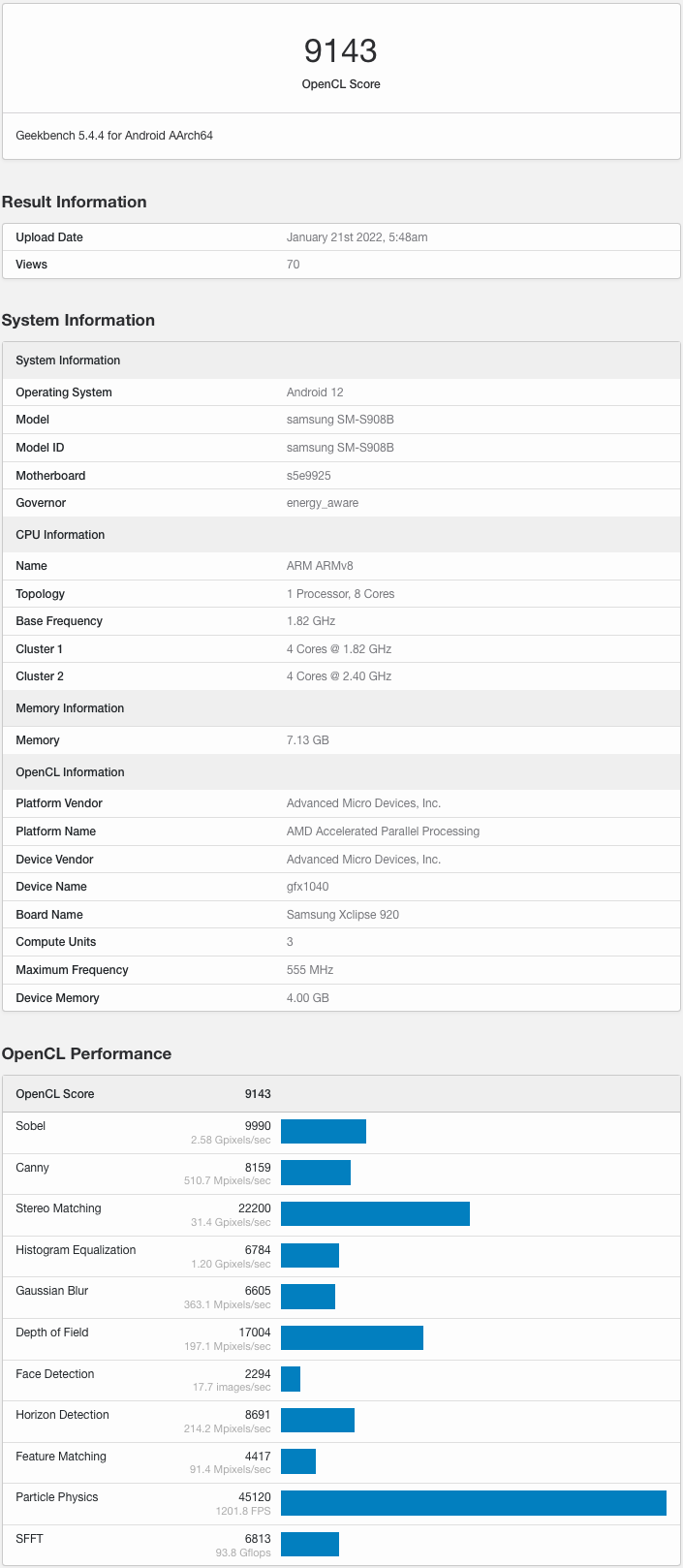Exynos 2200 with RDNA 2 Xclipse 920 GPU Gets Geekbenched
The first Geekbench 5 GPU compute benchmark results for the recently unveiled Samsung's Exynos 2200 chip with the AMD RDNA 2-powered Xclipse 920 GPU reveal that the new processor dramatically outperforms Qualcomm's Snapdragon 888 chip but still cannot match Apple's A15. As with all tests of pre-production hardware, take them with a grain of salt.
Samsung formally introduced its Exynos 2200 application processor several days ago, revealing all of its general specifications, like the type of CPU cores and the image signal processor's capabilities. However, it didn't disclose details about perhaps the most exciting aspect of the new chip — the Xclipse 920 GPU based on AMD's RDNA 2 architecture. On Friday, someone posted the very first Geekbench 5 compute benchmark results and revealed some basics about the graphics processor in the process. Needless to say, enthusiasts noticed the new entry almost immediately.
The device (presumably one of Samsung's upcoming smartphones) used for testing is marked as the Samsung SM-S908B. It runs Android 12 and is equipped with 8GB of system memory. The GPU appears to feature three workgroup processors (WGPs) or 384 stream processors operating at a surprisingly low 555 MHz frequency. The chip also has 4GB of memory (though we are not sure whether the GPU uses dedicated memory or can address 4GB of DRAM). Of course, the shockingly low frequency could be a reporting error, or this particular sample is outfitted with a GPU that's at least 2.3 times slower than the rumored specifications.
Mobile SoCs in Geekbench 5 Compute Benchmark
| Row 0 - Cell 0 | Exynos 2200 | Xclipse 920 384 SPs | Snapdragon 888 | Mali-G76 12-clusters | A15 | 5 GPU clusters |
| Total Score | 9143 | 4853 | 14556 |
| Row 2 - Cell 0 | Row 2 - Cell 1 | Row 2 - Cell 2 | Row 2 - Cell 3 |
| Sobel | 9900 | 5927 | 10989 |
| Canny | 8159 | 3954 | 10496 |
| Stereo Matching | 22200 | 10205 | 33645 |
| Histogram Equalization | 6784 | 4092 | 10203 |
| Gaussian Blur | 6605 | 3934 | 16020 |
| Depth of Field | 17004 | 9794 | 21347 |
| Face Detection | 2294 | 1797 | 7831 |
| Horizon Detection | 8691 | 5367 | 16204 |
| Feature Matching | 4417 | 2440 | 7568 |
| Particle Physics | 45120 | 26847 | 72976 |
| SFFT | 6813 | 1475 | 6548 |
| API | OpenCL | OpenCL | Metal |
| Link | https://bit.ly/3Amgf16 | https://bit.ly/32pGN5c | https://bit.ly/32rGsyY |
In either case, the Xclipse 920 GPU performs quite well in Primate Labs' Geekbench 5 GPU compute benchmark. It outperforms the Qualcomm Snapdragon 888 used in the Samsung Galaxy S21 by nearly 2x but falls behind the Apple A15 that powers the iPhone 13 Pro.
However, Geekbench 5 compute benchmark often doesn't reflect the performance of actual applications that use GPUs for general-purpose computing. Also, it does not reflect the performance of GPUs in graphics applications, so it is hard to draw any direct conclusions here. The only thing we can say at this point is that the Xclipse 920 seems to have potential. Meanwhile, if the Exynos 2200 arrives this autumn, it won't compete against Apple's A15 (which already outperforms it by 59% in the Geekbench 5 compute benchmark), but against Apple's next-generation A16.
Keeping in mind that the results were obtained on pre-production hardware and are essentially a leak, take them with a grain of salt.
Get Tom's Hardware's best news and in-depth reviews, straight to your inbox.

Anton Shilov is a contributing writer at Tom’s Hardware. Over the past couple of decades, he has covered everything from CPUs and GPUs to supercomputers and from modern process technologies and latest fab tools to high-tech industry trends.
-
gggplaya I expect Apple's chip to still beat it, but by 50% is still impressive on Apple's part.Reply
